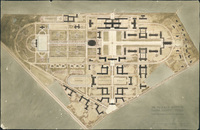Introduction
Through all ages men have found in architecture the permanent expression of the beauty of their character and of their spirit. The architect of today, so far as in his power lies, is expressing the beauty of his age. This beauty is the first measure of all architecture. It shall make our cities beloved; our colleges and schools inspiring; our homes charming and precious. Neither the complexities of modern demands nor the confusion of modern avenues of artistic expression should lead the architect away from the ceaseless search for the beauty that is possible of attainment in each of his buildings.
William Ward Watkin
William Ward Watkin was born in Boston, Massachusetts, on January 21, 1886. His parents were Fred W. Watkin and Mary Hancock Watkin. Watkin grew up in Pennsylvania, the home state of his mother's family. He graduated from Danville High School in 1903 and entered the University of Pennsylvania, pursuing the study of architecture under Paul Phillipe Cret. Following his graduation as number one in his class in 1908, Watkin spent one year traveling in Europe, principally in England.
Upon his return from Europe, Watkin joined the Boston office of Cram, Goodhue & Ferguson, then one of the most prominent architectural firms in the United States. At the time of Watkin's employment, 1909, Cram, Goodhue & Ferguson had received the commission to produce a campus plan and to design the initial buildings of the Rice Institute in Houston, Texas. Watkin worked on the development of both the campus plan and the building plan in the Boston office; when construction was to begin in the summer of 1910 Watkin was sent to Houston to serve as the firm's representative supervisor. As supervising architect he worked closely with Dr. Edgar Odell Lovett, President of the Rice Institute, and was offered a faculty appointment in Architectural Engineering at the Institute. Watkin became the first Chairman of the Rice Architecture Department, and began accepting independent commissions. He developed a thriving private practice in Houston and other Texas communities, designing buildings for educational institutions, commercial ventures, and residences. Watkin also wrote articles for journals primarily dealing with Houston, its growth and development, and the implications these held for the city's architecture.
Watkin had numerous academic, personal, and professional affiliations. He was a member of the Houston Philosophical Society, the Texas Philosophical Society, and the Houston Country Club. He was also a communicant of Trinity Church. Watkin was a charter member of the Rice Institute Faculty Club. He became a member of the American Institute of Architects in 1913, and was elected to its College of Fellows in 1949.
William Ward Watkin died on June 24, 1952 from complications following surgery for a broken kneecap. He was survived by his wife, Josephine Cockrell Watkin, whom he had married in 1933. Watkin had previously been married to Annie Ray Townsend Watkin, who died in 1929. Their three children were Annie Ray Watkin Biehl Hoagland Strange, Rosemary Watkin Barrick, and William Ward Watkin, Jr.


